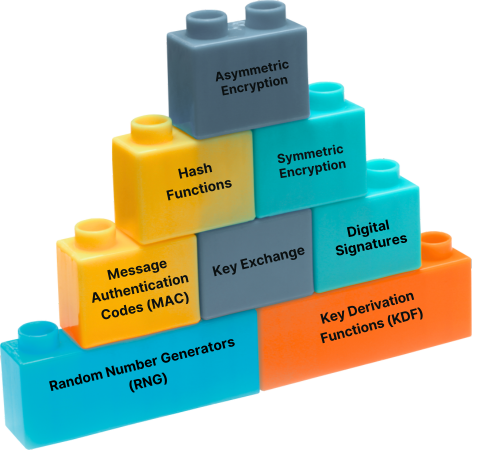
Cryptographic primitives are the foundation of secure IT systems. This blogpost explains the most important methods and their significance in practice.

Cryptographic primitives are the foundational building blocks of modern IT security. They enable data to be transmitted confidentially, ensure the integrity of information, and verify digital identities. Without them, secure communication and trustworthy digital processes would be impossible. This article provides an overview of the most important primitives and their practical relevance.
Symmetric encryption uses the same secret key to encrypt and decrypt data. A widely used example is the Advanced Encryption Standard (AES), which today is the standard for securing sensitive data. Symmetric methods are highly efficient but have the drawback that cryptographic keys must first be exchanged between the parties before secure communication is possible. For this reason, symmetric encryption is often combined with asymmetric methods in practice.
Asymmetric encryption uses a key pair: a public key for encryption and a private key for decryption. The public key can be publicly shared, while the private key must remain secret. This makes it possible for two parties to communicate securely without having to exchange a password beforehand. Asymmetric methods are significantly less efficient than symmetric ones.
To achieve maximum efficiency when encrypting large volumes of data while securely exchanging keys, algorithms such as RSA or Elliptic Curve Cryptography (ECC) are combined with AES in practice today. The much slower asymmetric method is used to encrypt and exchange only short keys. These shared session keys, exchanged during the key-agreement phase, are then used to encrypt the large amounts of data—such as application traffic—during transmission.

Digital signatures ensure that messages remain unchanged and originate from the stated sender. The holder of a private key can sign a message, and anyone with the corresponding public key can verify the signature. Algorithms such as ECDSA or RSA signatures are widely used. A further benefit: the authorship of a message canmot be denied —even to third parties.
Hash functions map inputs of arbitrary length to outputs of fixed length. They are used for checksums, password hashes in databases, or blockchain protocols. Well-known examples include SHA-256 and SHA-3.in.
A crypographically secure hash function must fulfill two properties:
MACs combine the approach of hash functions with the symmetric concept of a secret key. In practice, for example, block ciphers with a secret key are used to create a MAC. They ensure that a message is authentic and unchanged but can only be verified by parties that know the key.
Similar to asymmetric encryption, an asymmetric scheme with private and public keys is used. The goal is the secure exchange of key material that can then be used for other cryptographic primitives. In practice, key exchange functions—rather than asymmetric encryption itself—are almost exclusively used, as in TLS.
The security of cryptographic algorithms depends heavily on the quality of the cryptographic keys, because cryptographic keys should be indistinguishable from a random bitstream. Passwords are not good cryptographic keys, as their encoding introduces structure and predictability.
Key derivation functions transform passwords or other non-uniform inputs into strong cryptographic keys and often incorporate additional properties such as computational cost and memory usage to defend against brute-force attacks.
The security of cryptographic algorithms also depends on randomness. If secret keys can be guessed by brute force or predicted because they weren’t truly random, data cannot be protected. True random number generation (TRNG) is resource-intensive, so pseudo-random number generators (PRNGs) are often used. PRNGs expand a small random seed into a large sequence of bits suitable for cryptographic keys.
Without strong randomness, even robust algorithms can be broken.
Cryptographic primitives form the foundation of modern IT security. Their correct combination and secure implementation determine the trustworthiness of digital systems. While algorithms like AES, SHA-2, and ECDSA are currently considered secure, older methods such as DES or MD5 are no longer recommended. With emerging threats such as quantum computing, it is vital to stay up to date with new developments.
The recommendations above follow the current NIST cryptographic standards and guidelines.

